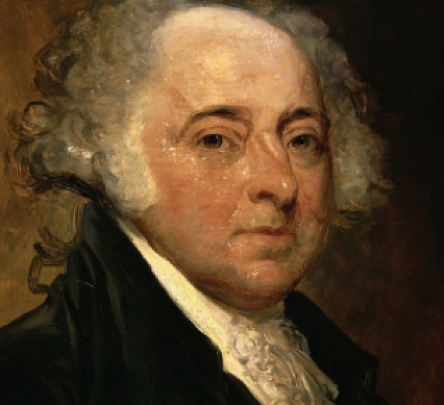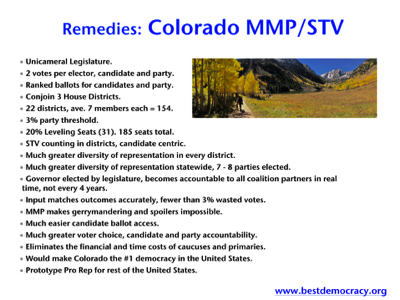A Case for Party List Proportional Representation
- Gary Swing
Check out the discussion and news feed on Best Democracy on Facebook.
Best Democracy Boulder County & Colorado Presentation (5.5 MB .pdf). This is a scalable formula. I will customize this presentation to any geography. Any district that adopts this system will be in the same league of democracies as New Zealand, Denmark and Ireland, after which the Colorado MMP/STV system is modeled. Please contact me. - Jesse
Sample Slide: Colorado MMP/STV
Join Best Democracy on Meetup.
Organize local Pro Rep events.
... a "representative assembly... should be in miniature an exact portrait of the people at large. It should think, feel, reason and act like them."
Under winner take all voting systems like those used in the United States, political minorities are excluded from representation.
Only two parties are represented in the United States Congress. No candidate representing a third party has been elected to Congress since 1970, Out of 7,383 seats in state legislatures, none are held by candidates who were elected as members of the nation's third or fourth-largest political parties.
In 2019, the Congress has more women than ever before. Women now account for 23 percent of the members of the U.S. House of Representatives and 25 percent of the U.S. Senate. The United States ranks in 78th place for representation of women in national legislatures.
For 2020, the Cook Political Report rates only five percent of the seats in the U.S. House of Representatives as truly competitive between the two major parties. Seventy-nine percent of Congressional districts are considered to be "safe seats" under the solid domination of one political party. For U.S. Senate races in 2020, only twelve percent are rated as truly competitive.
Members of Congress who run for re-election rarely lose. Ninety-one percent of incumbent U.S. Representatives were re-elected in 2018. In 2016, 97% were re-elected. In 2018, 83 percent of incumbent Senators were re-elected. In 2016, it was 93 percent.
The United States Senate violates the principles of fair representation. It should be abolished. Representation is for people, not for the "imaginary beings called states," as James Wilson argued. California now has more than sixty-eight times the population of Wyoming, but each state elects two Senators. Nine states with a majority of the United States population elect just eighteen percent of the U.S. Senate.
Proportional representation voting systems are designed to disperse power and provide fair representation for almost everyone.
In 1994, Bishop Desmond Tutu said: "The system of proportional representation ensures that virtually every constituency in the country will have a hearing in the national and provincial legislatures." In post-apartheid South Africa, more than ninety-eight percent of voters are able to elect representatives of their choice.
Ninety-four nations use proportional representation to secure fair, inclusive representation for diverse populations in their parliaments. Another thirty-four countries mix proportional representation with some winner take all elections. Three-fourths of European Union nations use proportional representation. The European Parliament is elected proportionally as well.
In a single transferable vote system, voters rank individual candidates in their order of preference. If your first choice candidate doesn’t have enough support to win, your ballot is transferred to your highest ranked candidate who can be helped by your ballot. In a district with nine seats, a candidate would need one-tenth of the vote to be elected.
Malta and Ireland use this system. In Australia, elections for the Senate allow voters to cast either a single transferable vote for individual candidates or a simple vote for their favorite party. More than 95% of voters choose to cast a simple vote for their favorite party instead of ranking individual candidates.
Most nations with proportional representation use some form of party-list voting.
The basic idea behind the party list vote is that each voter supports a list of candidates representing their favorite political party. Each political party is awarded seats in the legislature in proportion to its share of the vote. Five percent of the vote equals five percent of the seats. Candidates from each party list are seated in the order in which they appear on the list.
Party lists may be either open or closed. In a closed party list system, the party chooses the order of candidates on their list through the party’s own internal nominating process. The voter casts a simple vote for their favorite party.
Under an open party-list system, voters cast a vote for one or more individual candidates within a party list. The most popular candidates from each party are elected, but these votes also determine the total number of seats allotted to each party.
Seven nations use a system of mixed-member proportional representation allowing voters to cast two votes; one vote for their favorite party, and another vote for a candidate from a local district. Under most mixed-member systems, members of parliament are added on from the party list to make overall representation for each party proportional to the share of the vote cast for that party.
Nations that use party list systems to elect their legislators generally have higher voter turnout, better representation of women and ethnic minorities in government, more political parties in government, higher standards of living, and stronger environmental protections than nations that use winner-take-all voting methods.
As of 2013, nineteen of the twenty nations with the most women in Parliament used party list systems of proportional representation. Today, women account for 53 percent of Bolivia's national parliament, 48 percent of Mexico's parliament, and 45 percent of South Africa's National Assembly.
Many party list systems require a minimum percentage of the vote for a party to win seats. When this threshold is set low, almost all voters are able to elect representatives of their choice. Kazakhstan sets a threshold of 7% for representation. They have three parties in parliament. New Zealand sets a five percent threshold. They have five parties in parliament. Bolivia sets a 3% threshold. They have eight parties in parliament. Denmark has ten parties in government with a two percent threshold. South Africa has 14 parties in its 400 seat National Assembly. They have no artificial threshold.
The single transferable vote is appropriate for local, non-partisan elections like city councils or small boards like county commissions. For state legislatures and Congress, I prefer an open party list system with a minimal threshold, no higher than two or three percent to win representation.
Gary Swing, addressing 2019 Best Democracy Birthday Bash, Boulder, Colorado.

John Adams
Second President
In 1776 John Adams wrote an influential pamphlet “Thoughts on Government”.





